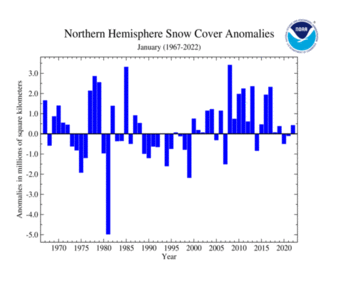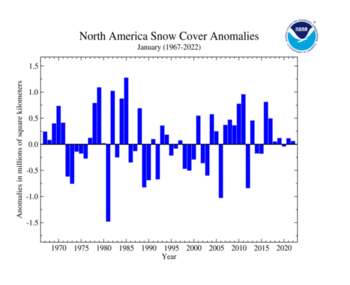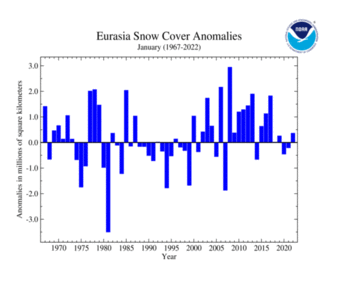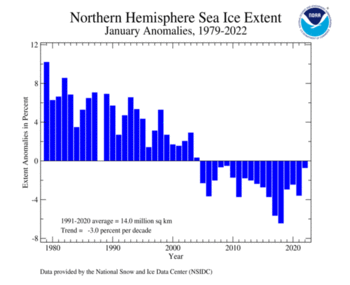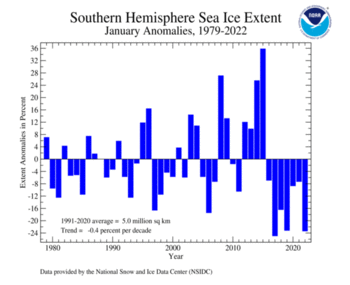NH Snow Cover Extent
| January 2022 | Snow Cover Extent | Anomaly 1991-2020 | Trend per decade | Rank (56 years) | Record | ||||||
|---|---|---|---|---|---|---|---|---|---|---|---|
| million km² | million mi² | million km² | million mi² | million km² | million mi² | Year(s) | million km² | million mi² | |||
| Northern Hemisphere | 47.29 | 18.26 | +0.05 | +0.02 | +0.12 | +0.05 | Largest | 26th | 2008 | 50.28 | 19.41 |
| Smallest | 31st | 1981 | 41.89 | 16.17 | |||||||
| North America | 17.60 | 6.80 | +0.01 | +0.00 | +0.01 | +0.00 | Largest | 30th | 1985 | 18.82 | 7.27 |
| Smallest | 27th | 1981 | 16.07 | 6.20 | |||||||
| Eurasia | 29.69 | 11.46 | +0.04 | +0.02 | +0.11 | +0.04 | Largest | 24th | 2008 | 32.27 | 12.46 |
| Smallest | 32nd | 1981 | 25.82 | 9.97 | |||||||
| Ties: 1982 | |||||||||||
Data Source: Global Snow Laboratory, Rutgers University. Period of record: 1967–2022 (56 years)
The Northern Hemisphere snow cover extent for January 2022 was 47.29 million square km (18.26 million square miles) or 420,000 square km (160,000 square miles) above average. This was the largest January Northern Hemisphere snow cover extent since 2017.
The North America snow cover extent for January 2022 was near average at 17.60 million square km (6.80 million square miles). Above-average January snow cover extent was observed across much of the Northeast and Mid-Atlantic, as well as parts of the northwestern contiguous U.S. and the northern Rocky Mountains. Below-average snow cover extent was observed across the southern Rocky Mountains and Great Plains. Alaska's January snow cover extent was above average and tied with six other years as the highest January extent on record. Canada was also above average and the 16th highest on record. The contiguous U.S. had a slightly below-average snow cover extent.
Across Eurasia, above-average snow cover extent was observed across parts of eastern and southeastern Europe, southwestern and northeastern China, eastern Afghanistan, and western Uzbekistan. Below-average snow cover extent was present across parts of central Europe, Turkmenistan, and northern and western China. As a whole, Eurasia's snow cover extent was slightly above average at 29.69 million square km (11.46 million square miles). This was also the largest January snow cover extent since 2017.
Sea Ice Extent
The sea ice extent data for the Arctic and Antarctic are provided by the National Snow and Ice Data Center (NSIDC) and are measured from passive microwave instruments onboard NOAA Satellites. The sea ice extent period of record is from 1979–2022 for a total of 44 years.
| January 2022 | Sea Ice Extent | Anomaly 1991-2020 | Trend per decade | Rank (44 years) | Record | ||||
|---|---|---|---|---|---|---|---|---|---|
| million km² | million mi² | Year(s) | million km² | million mi² | |||||
| Northern Hemisphere | 13.87 | 5.36 | -0.79% | -3.00% | Largest | 28th | 1979 | 15.41 | 5.95 |
| Smallest | 16th | 2018 | 13.08 | 5.05 | |||||
| Southern Hemisphere | 3.94 | 1.52 | -21.83% | -0.20% | Largest | 41st | 2015 | 6.85 | 2.64 |
| Smallest | 3rd | 2017 | 3.78 | 1.46 | |||||
| Globe | 17.81 | 6.88 | -6.36% | -2.26% | Largest | 39th | 1979 | 20.81 | 8.03 |
| Smallest | 5th | 2017 | 16.97 | 6.55 | |||||
Data Source: National Snow and Ice Data Center (NSIDC). Period of record: 1979–2022 (44 years)
According to the NSIDC, January 2022 was warmer than average across the Arctic, with temperatures up to 7.0°C (13.0°F) above average across parts of the northern Canadian Archipelago. Overall, the January 2022 Arctic sea ice extent was 13.88 million square km (5.36 million square miles) or 540,000 square km (208,000 square miles) below the 1981–2010 average. Although the monthly extent was below average for the month, it was the largest January sea ice extent since 2009. Regional sea ice extent was below average in the Sea of Okhotsk, Barents Sea and the Gulf of St. Lawrence, while the Bering Sea had above-average January extent.
The Antarctic sea ice extent for January 2022 was the second smallest for January in the 44-year record at 3.86 million square km (1.49 million square miles). This is 1.14 million square km (440,000 square miles) below average. Only January of 2017 had a smaller sea ice extent at 1.22 million square km (470,000 square miles) below average.
 NOAA's National Centers for Environmental Information
NOAA's National Centers for Environmental Information
